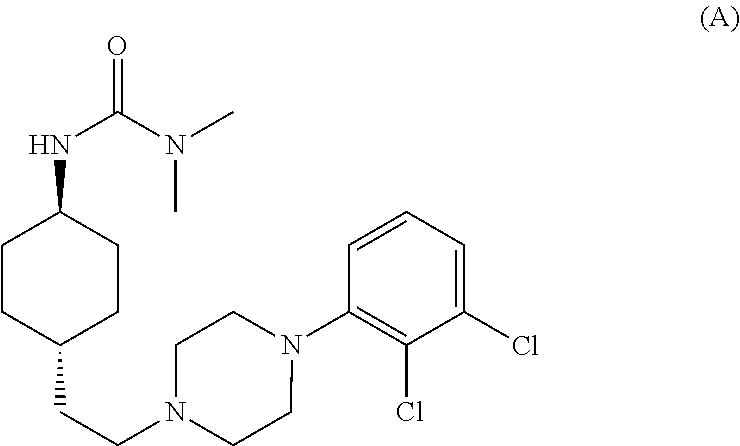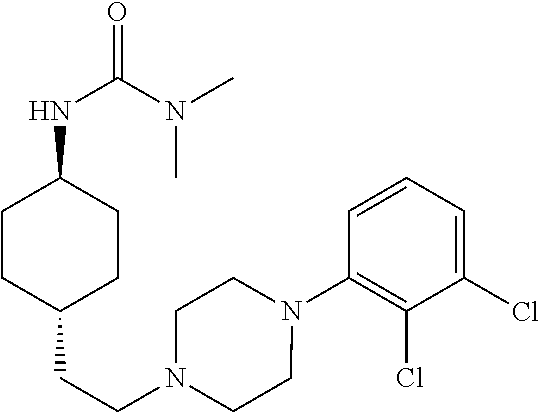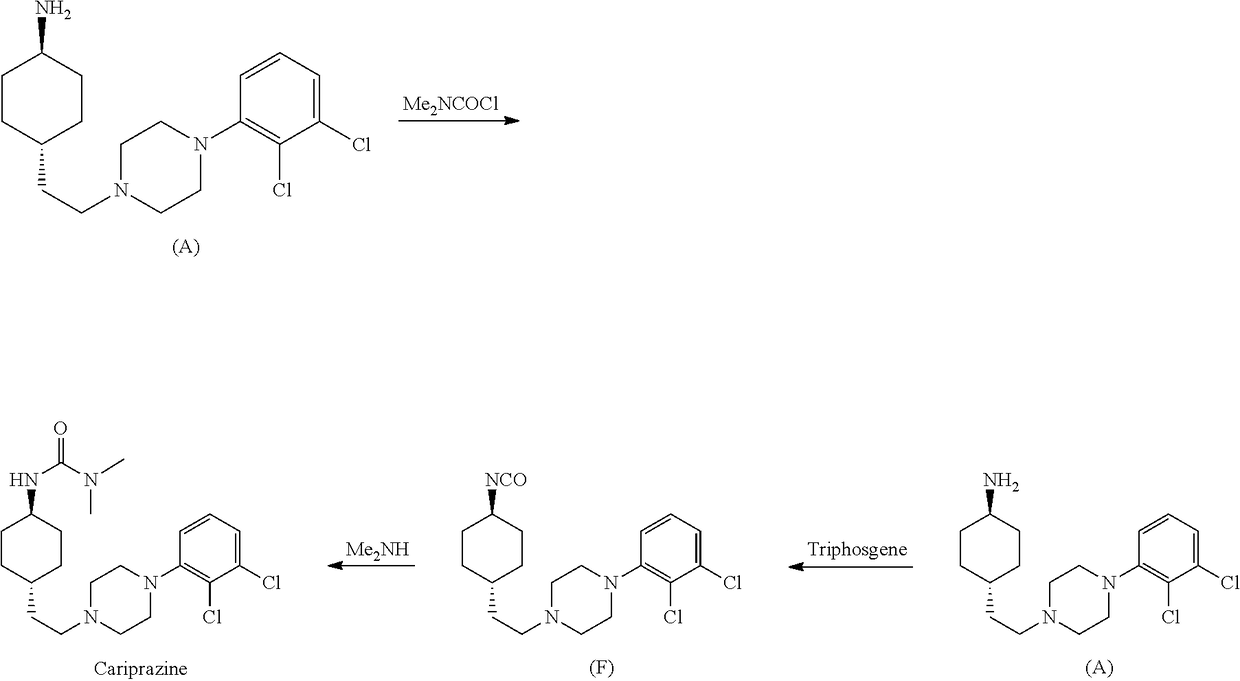1,4-cyclohexylamine derivatives and processes for the preparation thereof
a technology of cyclohexylamine and process, applied in the field of 1,4-cyclohexylamine derivatives and processes for the preparation of thereof, can solve the problems of high toxicity and probable cancerogenicity of dimethylcarbamoyl
- Summary
- Abstract
- Description
- Claims
- Application Information
AI Technical Summary
Benefits of technology
Problems solved by technology
Method used
Image
Examples
example 1
Preparation of trans-tert-butyl 4-(2-(4-(2,3-dichlorophenyl)piperazin-1-yl)ethyl)cyclohexyl carbamate
[0115]
[0116]Alcohol 1 (50 mg, 0.20 mmol), 1-(2,3-dichlorophenyl)piperazine (55 mg, 0.24 mmol), Ru3(CO)12 (5 mg, 7.8 μmol) and Xantphos (7 mg, 12.1 μmol) are dissolved in toluene (5 mL) and the mixture is heated to the reflux temperature of the solvent for 12 hours. After solvent evaporation, the product is purified by flash chromatography eluting with CHCl3 / MeOH 9:1. 56 mg of compound 2 are obtained (yield: 60%).
[0117]1H NMR: (400 MHz, CDCl3): δ 0.98-1.05 (m, 4H), 1.19-1.21 (m, 1H), 1.36-1.40 (m, 11H), 1.72-1.75 (m, 2H), 1.94-1.96 (m, 2H), 2.36-2.40 (m, 2H), 2.58 (m, 4H), 3.02 (m, 4H), 3.33 (m, 1H), 4.36 (m, 1H), 6.90-6.93 (m, 1H), 7.06-7.11 (m, 2H).
example 2
Preparation of trans-4-(2-(4-(2,3-dichlorophenyl)piperazin-1-yl)ethyl)cyclohexylamine
[0118]
[0119]Compound 2 (300 mg, 0.66 mmol) is dissolved in a 4:1 mixture of CH2Cl2 / TFA (3 mL). The mixture is allowed to react for 12 hours. After solvent evaporation, the product is purified by flash chromatography eluting with CHCl3 / MeOH 8:2. 205 mg of compound 3 are obtained (yield: 87%).
[0120]1H NMR: (400 MHz, CDCl3): δ 1.06-1.16 (m, 2H), 1.35-1.41 (m, 3H), 1.63-1.69 (m, 2H), 1.86-2.05 (m, 4H), 3.02-3.31 (m, 7H), 3.44-3.47 (m, 2H), 3.63-3.67 (m, 2H), 7.08-6.09 (m, 1H), 7.23 (m, 2H).
example 3
Preparation of N-[trans-4-[2-[4-(2,3-dichlorophenyl)-1-piperazinyl]ethyl]cyclohexyl]-N′,N′-dimethyl urea
[0121]
[0122]CDI (86 mg, 0.53 mmol) and compound 3 (170 mg, 0.48 mmol) are dissolved in a mixture of DMF (500 μL) and CH3CN (1.5 mL); the resulting mixture is allowed to react at room temperature for 2 hours. After solvent evaporation, the product is purified by flash chromatography eluting with CHCl3 / MeOH 9:1. 147 mg of compound 4 are obtained (yield: 68%).
[0123]1H NMR: (400 MHz, CDCl3): δ 1.02-1.43 (m, 7H), 1.77-1.81 (m, 2H), 2.02-2.05 (m, 2H), 2.41 (t, J=7.6 Hz, 2H), 2.61 (m, 4H), 3.04 (m, 4H) 3.74-3.76 (m, 1H), 6.91-5.92 (m, 1H), 6.99-7.11 (m, 3H), 7.46-7.49 (m, 1H), 7.65 (s, 1H), 8.21 (s, 1H).
[0124]13C NMR: (100 MHz, CDCl3): δ 31.4 (2C), 32.2 (2C), 33.3, 34.9, 50.3, 50.8 (2C), 52.9 (2C), 56.1, 116.1, 118.2, 121.4, 124.2, 127.0, 129.2, 134.6, 135.7, 148.1, 150.7.
[0125]Compound 4 (110 mg, 0.24 mmol) is dissolved in CH2Cl2 (3 mL); to this solution, dimethylamine hydrochloride (19...
PUM
| Property | Measurement | Unit |
|---|---|---|
| chemical structure | aaaaa | aaaaa |
| affinity | aaaaa | aaaaa |
| cryogenic temperatures | aaaaa | aaaaa |
Abstract
Description
Claims
Application Information
 Login to View More
Login to View More - R&D
- Intellectual Property
- Life Sciences
- Materials
- Tech Scout
- Unparalleled Data Quality
- Higher Quality Content
- 60% Fewer Hallucinations
Browse by: Latest US Patents, China's latest patents, Technical Efficacy Thesaurus, Application Domain, Technology Topic, Popular Technical Reports.
© 2025 PatSnap. All rights reserved.Legal|Privacy policy|Modern Slavery Act Transparency Statement|Sitemap|About US| Contact US: help@patsnap.com



